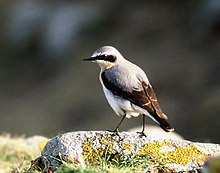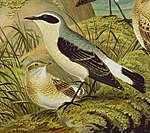Wheatear
| Wheatears | |
|---|---|

| |
| Northern Wheatear (male) | |
| Scientific classification | |
| Kingdom: | |
| Phylum: | |
| Class: | |
| Order: | |
| Family: | |
| Genus: | Oenanthe Vieillot, 1816
|
| Species | |
|
See text. | |

The wheatears (Template:PronEng) are birds of the genus Oenanthe. They were formerly considered to be members of the thrush family Turdidae, but are now more commonly placed in the flycatcher family Muscicapidae. This is an Old World group, but the Northern Wheatear has established a foothold in eastern Canada and Greenland and in western Canada and Alaska.
Oenanthe is also the name of a plant genus, the water dropworts, and is derived from the Greek ainos "wine" and anthos "flower". In the case of the plant genus, it refers to the wine-like scent of the flowers.[1] In the case of the wheatear, it refers to the Northern Wheatear's return to Greece in the spring just as the grapevines blossom.[2]
They are terrestrial insectivorous passerine birds of open, often dry, country. They often nest in rock crevices or disused burrows.
Northern species are long-distance migrants, wintering in Africa.
Wheatears are typically larger than the European Robin. Most species have characteristic black and white or red and white markings on their rumps or their long tails.
Most species are strongly sexually dimorphic; only the male has the striking plumage patterns characteristic of the genus, though the females share the white or red rump patches.
Its English name is not derived from "wheat" or any sense of "ear", but is altered from "white" and "arse", which refers to its prominent white rump.[3]
The wheatear species are:
- Northern Wheatear, Oenanthe oenanthe
- Isabelline Wheatear, Oenanthe isabellina
- Desert Wheatear, Oenanthe deserti
- Black-eared Wheatear, Oenanthe hispanica
- Pied Wheatear, Oenanthe pleschanka
- Cyprus Wheatear, Oenanthe cypriaca
- Finsch's Wheatear, Oenanthe finschii
- Mourning Wheatear, Oenanthe lugens
- Hooded Wheatear, Oenanthe monacha
- White-crowned Wheatear, Oenanthe leucopyga
- Black Wheatear, Oenanthe leucura
- Persian Wheatear or Red-tailed Wheatear, Oenanthe xanthoprymna
- Red-rumped Wheatear, Oenanthe moesta
- Hume's Wheatear, Oenanthe alboniger
- Mountain Wheatear, Oenanthe monticola
- Somali Wheatear, Oenanthe phillipsi
- Variable Wheatear, Oenanthe picata
- Capped Wheatear, Oenanthe pileata
- Red-breasted Wheatear, Oenanthe bottae
- Heuglin's Wheatear, Oenanthe heuglini
References
- ^ "Dropwort, Hemlock Water". A Modern herbal. Botanical.com. Retrieved 2008-02-05.
- ^ "Northern Wheatear". eNature. Retrieved 2008-02-05.
- ^ New Shorter Oxford English Dictionary, 1993.
